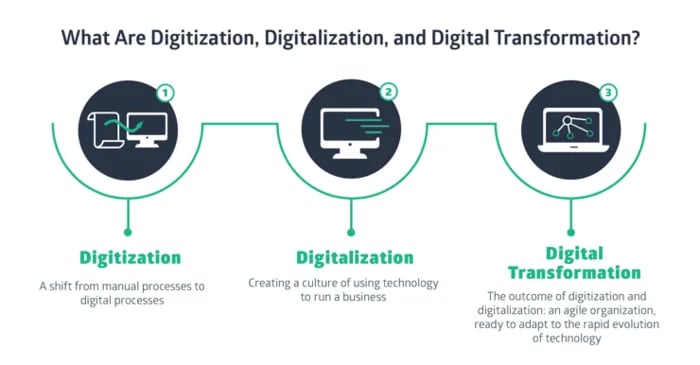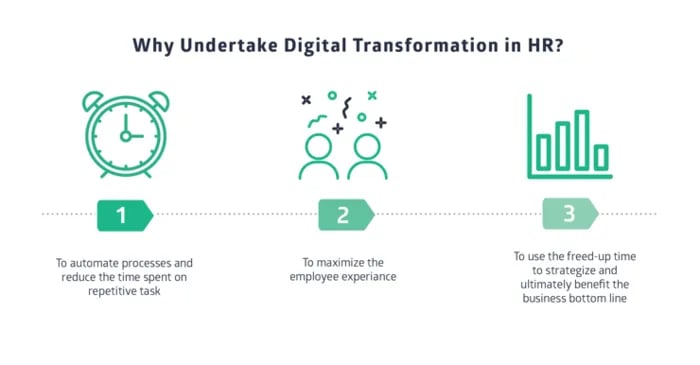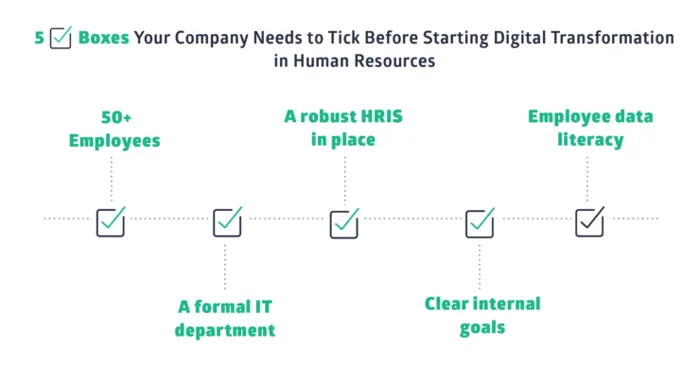The Ultimate Guide to HR Digital Transformation (Part 1)

In this 4-part series on the Complete Digital Transformation of Human Resources, we’ll shed some light on the whys of HR digital transformation. But, more importantly, we’ll show you the step-by-step process of how to implement it in your organization successfully.
HR digital transformation is still proving to be challenging for a lot of organizations. A few years back, HR professionals were still weighing the whys and the why-nots of digital transformation. Is it just a buzzword and a fad? Or is it the way for HR departments to move forward?
Today, we know that successful HR digital transformation is crucially vital for business success. It’s how we take recruitment, talent development, and performance evaluation to the next level. And it’s how we turn HR departments into true value-creating centers.
Why isn't simply moving from manual to digital processes enough? How to get the management on your side and build interdepartmental teams? What does success even look like when it comes to HR digital transformation?
In this first part, we’ll tackle the basics of digital transformation in human resource management:
- What is the difference between digitization, digitalization, and HR digital transformation
- What is digital transformation in HR, and what are its goals and benefits
- When should a company commit to pursuing HR digital transformation
HR digital transformation vs. digitization and digitalization
Yes, there is a difference between Hr digitization, HR digitalization, and HR digital transformation, even though everyone is using them interchangeably. That difference is subtle but crucial for you to understand before you start fiddling with your HR processes.
HR digitization, HR digitalization, and HR digital transformation are different stages of the HR transformation process. Where you are in that process will determine the actions you need to take to move forward to complete HR digital transformation.

- HR Digitization. Today, digitization in HR is common. It means moving away from manual and paper-driven record-keeping and embracing digital solutions.
- HR Digitalization. With HR digitalization, you’re going a step further. You’re now using technology to add value and improve HR processes. For example, various collaboration tools allow HR professionals (recruiters, compliance officers, and talent experts) to create a perfect onboarding experience tailored to a particular role.
- HR Digital Transformation. This right here is the Holy Grail for HR professionals. HR digital transformation is enabled by digitization and digitalization. But it also includes a healthy dose of artificial intelligence and process automation. A perfect example of HR digital transformation is a fully automated recruitment process, where software makes accurate hiring predictions and guides you toward the perfect fit for your company.
Many companies are just out of the digitization stage, making those first crucial steps toward HR digitalization. The road to the final stage, to the complete HR digital transformation, is still long, but now that you know where you are, it’s easier to plot the course (and avoid the usual pitfalls).
What is HR digital transformation?
There is no one overarching definition of HR digital transformation. The one I prescribe to is from Deloitte’s 2017 Human Capital Trends report:
“[HR digital transformation]... is about HR teams using technology and data to take up the dual challenge of transforming how HR operations are executed on one side, and transforming the workforce and the way work is done on the other.”
This definition combines everything necessary for a successful HR digital transformation project. It puts technology and data front and center and focuses on both processes and the organizational culture.
And that’s the ultimate goal of DT in HR — to overhaul HR on an organizational level by using technologies similar to those used by Marketing and Sales teams.
The outcome of well-executed HR digital transformation is always three-fold:
- Automation of time-consuming processes
- Maximization of employee experience
- The time freed up for high-level HR strategizing

Once this is accomplished, you can finally make a dent in the myriad problems that HR departments face. Will turning HR 100% digital eliminate these expenses?
No, it won’t. But it could reduce them. However, it’s important to note that this isn’t the case for every organization. Before you start the complex process of HR digital transformation, make sure your company ticks the following five boxes that signal that you’re, in fact, ready for this undertaking.

- More than 50 employees. For most companies, transforming how HR is done doesn’t make sense until they hit 50 employees. There are several reasons for this, economies of scale and return on investment being the two most important ones.
- A formal IT department. Your primary partner in an HR transformation project is your IT department. You’ll need at least one qualified person to help you with integrations, data security, and logistics, and tackling all of that with an IT temp is not possible.
- Employee data literacy. HR digital transformation is about letting data guide your decisions. Make sure you and your colleagues are comfortable working with large datasets. Or, hire a data expert who will help you translate those numbers into workable policies and strategies.
- A robust HRIS in place. Human resources information system is the type of software at the core of every successful HR digital transformation. It collects thousands of data points that you’re going to need for future software and solution implementations.
- Clear internal goals. HR digital transformation is not about modernization. And it’s not about doing what your competition is doing. It’s about accomplishing clear internal goals that will ultimately lead to a fatter bottom line. Before starting this project, think about what you want to do — reduce time-to-hire by 20 days, reduce onboarding mistakes by 25%, and similar.
Data and automation to unlock the power of human resources
HR departments are not really known for their readiness to embrace pioneering technologies. But the complexity of HR digital transformation is pushing the industry into new and exciting experimentation. One of the most promising solutions to the problem of disparate and disjointed HR ecosystems is none other than artificial intelligence.
Which we will explore in The Ultimate Guide to HR Digital Transformation (Part 2). Read it here!